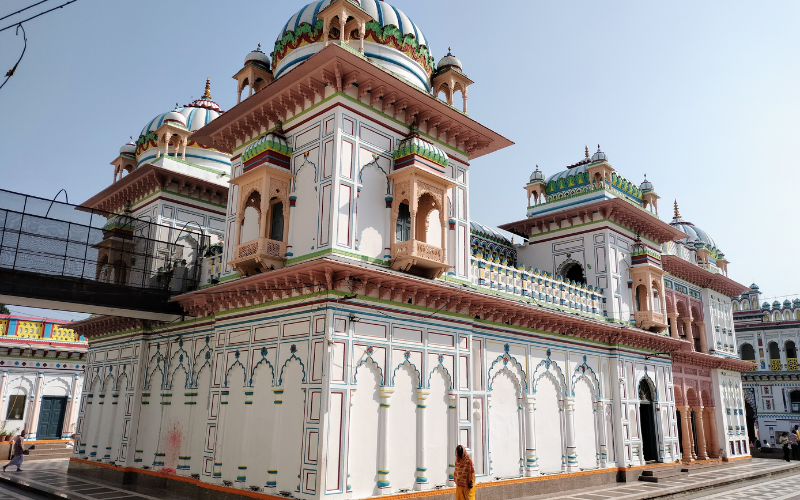Janakpurdham—often called Janakpur—is one of Nepal’s most culturally rich and spiritually celebrated cities. Located in Dhanusha District in the Madhesh Province, it holds a unique identity as both a major Hindu pilgrimage destination and a vibrant center of Maithili culture. The city’s significance has been shaped for centuries by traditions rooted in the ancient Hindu epic, the Ramayana, and by the living heritage of the Mithila region.
Mythological and Historical Significance
According to the Ramayana, Janakpurdham was the capital of the ancient kingdom of Mithila, ruled by King Janaka, who is revered in Hindu tradition for his wisdom and spiritual discipline. It is traditionally believed to be the birthplace of Sita, also known as Janaki, who was discovered in a furrow when King Janaka was ploughing the land during a sacred ritual.
While these stories are mythological rather than historically verified, they play a central role in shaping the identity of the city. Janakpur’s connection to the Treta Yuga, a mythological era said to stretch back thousands of years, highlighting its importance in the religious and cultural imagination of South Asia.
Major Monuments and Sacred Sites
The most iconic landmark in Janakpurdham is the Janaki Mandir, a grand white-marble temple built in 1910 by Queen Vrisha Bhanu of Tikamgarh. The temple’s three-story structure includes numerous rooms and intricately designed elements that reflect a blend of Mughal and classical Hindu architecture.
Inside the temple, visitors find beautifully adorned images of Sita and Rama, making it a central point of devotion. Adjacent to the temple stands the Ram-Sita Vivaha Mandap, a pavilion that commemorates the divine marriage of Rama and Sita. This site becomes particularly significant during the annual Vivaha Panchami celebration, when reenactments of the wedding draw thousands of pilgrims.
The city is also home to several other temples dedicated to deities such as Rama, Laxman, and Hanuman, each contributing to Janakpur’s religious landscape. Nearby, a temple dedicated to Yogamaya adds to the city’s spiritual diversity. These sacred spaces collectively uphold Janakpur’s status as an important devotional center.

Sacred Ponds and Ritual Spaces
Janakpurdham is further distinguished by its large number of sacred ponds, which are deeply connected to the city’s religious traditions.
Among them are Ganga Sagar, a pond believed in legend never to dry up, and Dhanush Sagar, which is traditionally linked to the bow of Lord Shiva mentioned in the Ramayana. These ponds serve as important ritual sites, especially during major festivals when devotees gather to perform ceremonial baths and offer prayers.
Cultural Heritage of Mithila
Beyond its religious importance, Janakpurdham is a cultural stronghold of the Mithila region. Maithili language, literature, and traditions are woven into everyday life. The city is also an important center for Mithila art, known internationally for its vibrant colors, symbolic motifs, and depictions of mythological themes.
Local women play a central role in preserving and transmitting this artistic tradition, and various community organizations help promote Mithila painting and crafts. This artistic heritage adds a distinctive cultural depth to Janakpur, drawing interest from scholars, travellers, and art enthusiasts.
Festivals and Celebrations
Janakpurdham is especially lively during its festivals, the most celebrated being Vivaha Panchami, which commemorates the marriage of Rama and Sita. During this festival, the city’s temples and streets become scenes of immense devotion, music, and reenactments. Rama Navami, marking the birth of Lord Rama, is another major celebration observed with great enthusiasm.
The city also witnesses large gatherings during Chhath Puja, when devotees worship the Sun God along the banks of sacred ponds. Festivals such as Dipawali and Vijayadashami add to the city’s festive cycle, reflecting the broader cultural and religious traditions of the region.
Today, Janakpurdham continues to flourish as a pilgrimage destination and cultural hub. Its accessibility by road and air—through Janakpur Airport—has made it easier for visitors from Nepal and India to reach the city. While the growing number of pilgrims and tourists places pressure on infrastructure, ongoing development efforts aim to enhance heritage preservation and promote sustainable tourism. Janakpur’s enduring appeal lies in its unique blend of mythological significance, historical monuments, artistic traditions, and living cultural practices.
PC: Wikimedia Commons
Also Read